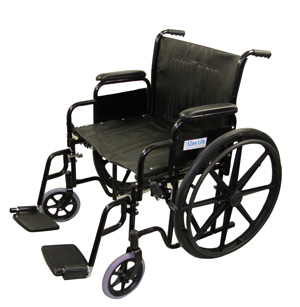Importance of Wheelchair Weight
Over the past fifty years or so the wheelchair manufacturers have striven to make their products lighter and lighter by using lightweight materials such as aluminum in place of the steel frames and components.
They have managed to reduce the weight of a standard folding wheelchair by 10 to 20 pounds but have increased the cost of these chairs from $500.00 to more than a $1,000.00 before accessories and options.
The question is, is it worth the added expense to have a wheelchair that is 30 to 40 pounds instead of 50 to 60 pounds. For athletes where 100ths of a second matters, the answer would obviously be yes but for the every day user the answer isn’t so clear.
If the wheelchair user weighs 160 pounds and they are using a wheelchair weighing 40 pounds their total weight will be 200 pounds. If the same user has a wheelchair that weighs 60 pounds their total weight will be 220 pounds. In this case, the standard weight wheelchair is 50% heavier than the lightweight wheelchair but once the user sits in the chair the difference in weight is about 10%.
If the user happens to weigh 200 pounds, the difference between the two total weights is closer to 8%. As the user’s weight increases, the overall difference in weight between the two wheelchairs is lowered until it’s almost negligible.
Even with our original 160 pound user the difference in weight between the standard and lightweight wheelchairs would hardly be noticeable when they are self-propelling or being pushed by a caregiver. In fact, if the lightweight wheelchair has smaller wheels or the frame is so light it flexes when being pushed there might be no difference at all.
There are instances where the weight of a wheelchair is an important factor but they usually have little to do with the user. The factors that make the weight important are usually related to the caregivers.
If the chair has to be lifted into a vehicle, or anywhere else for that matter, then the difference in weight between a 40 pound chair and a 60 pound chair will be significant and may well be worth the added cost.
The weights I’ve quoted in this article are typical for standard folding wheelchairs. Non-folding rigid or sports wheelchairs will be lighter and reclining or tilting wheelchairs will be much heavier in weight.
If weight will be a factor when choosing a wheelchair it’s important that the buyer check the specifications closely. Some manufacturers publish their product weights with footrests and/or armrests excluded. I’ve actually seen a sports chair manufacturer exclude the wheels from the weight computations.


 Online Vendors
Online Vendors  US Online Vendors
US Online Vendors 


